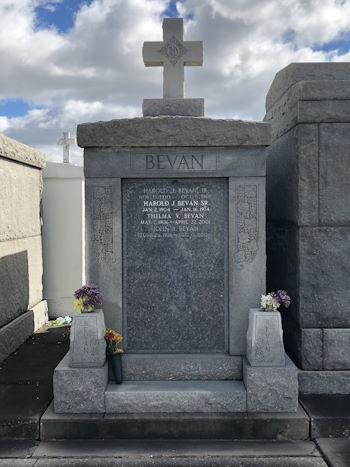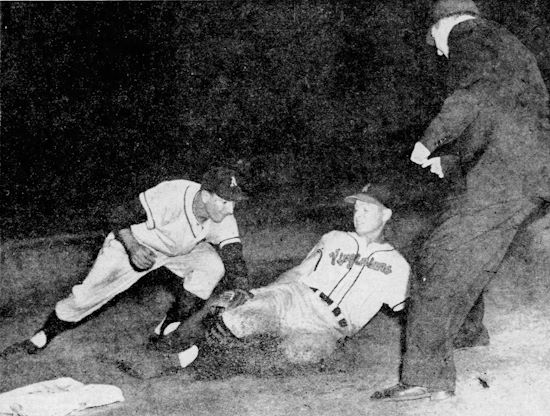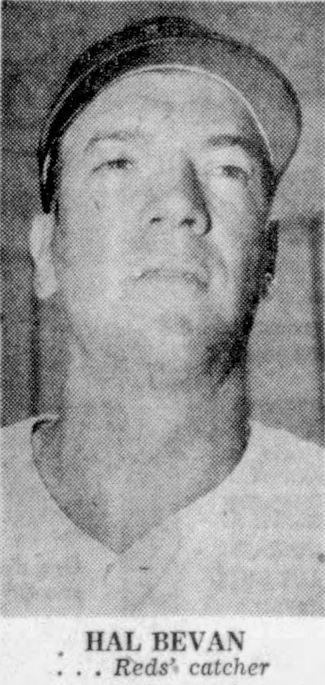Hal Bevan could be the patron saint of cup-of-coffee ballplayers. In spite of an excellent minor-league career, Bevan’s total experience in the major leagues amounted to 15 games, for three different teams, over the course of a decade. Bevan played for the Boston Red Sox (1952), Philadelphia/Kansas City Athletics (1952, 1955) and Cincinnati Reds (1961).
Harold Joseph Bevan Jr. was born in New Orleans on November 15, 1930, though he went by Joseph Harold Bevan or Joe Bevan early in his baseball career. He was the only son of Harold, a liquor salesman, and Thelma Bevan. He also had a sister, Ann, who was 9 years his junior. A cousin, George Bevan Strickland, had a 10-year playing career in the majors. Bevan went to S.J. Peters High School, which also was the school for future major-leaguers Strickland, Jack Kramer and Mel Parnell. He also played American Legion baseball and hit close to .400 in 1947. On June 22, 1948, he signed with the New Orleans Pelicans of the Southern Association, courtesy of general manager Vince Rizzo.

Bevan debuted professionally with the Rehoboth Beach Pirates of the Eastern Shore League later that year. Playing as a shortstop, he batted .271 with 1 homer. He would move all over the infield as he played on various Pelicans farm teams. He reached New Orleans briefly in 1949 but spent most of the season with Class-C Modesto. He hit .330 for Modesto and then batted .393 for Waco in 1950. Not only was he one of the best hitters in the Big State League, but he was voted as having the prettiest knees – as decided when the team wore shorts instead of long baseball pants. Bevan was summoned to New Orleans but struggled with the Pels, hitting .237 for the team over the rest of the 1950 season. He had a few highlights, including a 4-for-6 game against Little Rock on July 15. His last hit of the game was a 12th-inning double, and he scored the winning run on an Al Grunwald single.
New Orleans was part of the Pittsburgh farm system, and Bevan was expected to be the first baseman in a talented infield. He ended up playing first and second base to good effect (and shortstop to bad effect, as evidenced by an .880 fielding percentage). He hit .286 for New Orleans and homered 7 times, which was a career high to that point. His success didn’t get him promoted to Pittsburgh, but it spurred the Boston Red Sox to take him in the minor league draft. Sox scout Ted McGrew made the recommendation. “I think he has a chance to be the Red Sox first or third baseman. He can play any infield position,” he said.
Bevan played in a total of one game for the Red Sox. He debuted as the starting third baseman against the Yankees on April 24, 1952. He grounded out against Eddie Lopat in his first at-bat, and when Lopat loaded the bases in the bottom of the fourth inning, manager Lou Boudreau replaced Bevon with pinch-hitter Vern Stephens, who flew out to end the inning. The Philadelphia A’s purchased Bevan’s contract on May 3, but the team didn’t do much with him at first. After spending a month playing in a handful of games as a pinch-runner or defensive replacement, Bevan was given a start at third base against the White Sox on June 10. He went 1-for-4 with a 2-run single off Billy Pierce. In the next game, he had 3 hits, an RBI and a stolen base. On June 12, he was held hitless by Chicago but added an RBI and another stolen base. The A’s then traveled to St. Louis, and Bevan got 2 more hits on the 13th, including a bunt single in the top of the sixth inning that loaded the bases. He made it to second base and then came around to score on an Eddie Joost single. That was when disaster struck. Bevan slid into home plate and suffered a broken leg and dislocated ankle. He had been the A’s starting third baseman for four games.

“When I got to the hospital, the leg was black. A lot of blood vessels had been broken,” Bevan recalled in a 1961 interview. “The ankle was in a cast for seven months.”
During his short time with the A’s, Bevan hit .353, with 6 hits, 4 RBIs and 2 stolen bases in 8 games. The injury not only ended his season, but it carried over into 1953. He was a late addition to spring training and did not make the A’s roster, despite manager Jimmie Dykes hoping that he could fill the hole at third base. Bevan was assigned to Triple-A Ottawa, and he spent all of 1953 and ’54 there. He hit over .300 each year and added 23 doubles and 60 RBIs in 1954. Bevan rejoined the Athletics in 1955, which was their first season in Kansas City. By then, the team’s starting third baseman was Hector Lopez, a strong hitter but a poor fielder who would later transition to the outfield. Bevan, who despite his experience was actually younger than Lopez, was hitless in 3 at-bats as a pinch-hitter before he was sent to Triple-A Columbus.

In September 1955, Kansas City traded Bevan to the Cincinnati Reds for catcher Ray Noble. He was 25 years old, with 8 years of experience in pro ball, and he demonstrated the ability to hit well in the minors and hold his own at any position in the infield besides shortstop. But Cincinnati promptly forgot that Bevan existed. He hit .302 with 62 RBIs for the Havana Sugar Kings in 1956, and then he spent the next four seasons with the Seattle Rainiers of the Pacific Coast League. He put together some outstanding seasons, too. In 1957, he lost out on the Reds’ last roster spot to Don Hoak and Alex Grammas, so he slashed .271/.330/.441 with Seattle. He reached career highs with 23 home runs and 90 RBIs. He regressed a little in 1958 as his hitting slipped to .268, but he increased his versatility by turning himself into a credible catcher. He was following the advice of Rainers general manager and future Seattle Pilots owner Dewey Soriano, who told him to switch to catching. “It’s the only way you have a chance of getting to the major leagues,” Soriano reportedly told him.
Bevan bounced back in 1959 and finished in the Top 10 in the PCL in hitting, with a .322 mark. (To give you an idea of how stacked the PCL was for talent in 1959, the Top 10 hitters also included Willie McCovey, Tommy Davis, Brooks Robinson, Frank Howard and Maury Wills.) Bevan was named the Rainers’ player of the year, as voted upon by PCL sportswriters and broadcasters. He repeated the honor in 1960, when he batted .305 with 27 doubles. He and Tacoma’s Tom Haller were named the PCL All-Star Team’s catchers.

In September 1961, the Reds purchased the contracts of Bevan and pitcher Ray Rippelmeyer. Bevan had been thinking of quitting baseball, but being added to the Reds’ roster gave him some hope for 1961. He impressed Reds manager Fred Hutchinson during spring training. “Bevan’s versatility makes him a valuable man on the bench. He can catch, fill in at first or third, and he’s a good hitter,” the manager said. As one of only three catchers on the Reds roster, the odds of making the team were in Bevan’s favor. “I know I haven’t got it made, but it’s a comforting feeling,” he said.
Unfortunately, Bevan broke the middle finger on his right hand when he was hit by a foul tip, and he missed the start of the ’61 season. Once he was healthy, he joined the Reds roster. He was 30 years old and six seasons removed from his last major-league experience. His right ankle was pretty much permanently swollen, and his speed was long gone. “I don’t do so bad on a straightaway, but I have a little trouble making the turns,” he said. For all the work he put into becoming a catcher, he never got behind the plate with the Reds. He made three pinch-hit appearances, and he struck out in two of them. But in the game on May 12 against Pittsburgh, he pinch-hit for pitcher Bob Purkey and hit a home run to deep left against Vinegar Bend Mizell. It was his first major-league home run, and his last major-league hit.
The Reds returned Bevan to the minors shortly after his homer, and he split the rest of the season with Jersey City and Indianapolis. He played for a final year in 1962, for San Diego of the PCL. He continued to feast off PCL pitching, batting .307. He also hit 12 home runs, including 3 in a game in Portland. Bevan had hit so many home runs in Portland that the team acquired him for 1963, hoping all those homers would count in their favor. But before the season opened, Bevan told the team he was retiring to continue his offseason job as a general manager at a business in New Orleans.
In Bevan’s 15 major-league games, across 3 seasons and 10 years, he slashed .292/.292/.417. He had 7 hits in 24 at-bats, including the one home run. He had 5 RBIs, 2 runs scored and 2 stolen bases. He played 42 innings at third base and never made an error in 15 chances. In 14 seasons in the minor leagues, Bevan had 1,618 hits and a .295 batting average, with 90 home runs and 740 RBIs.
Bevan remained in New Orleans for the rest of his life. He worked as a scout for the Milwaukee/Atlanta Braves and participated in many baseball clinics and events with other ex-big leaguers living in town. According to his SABR biography, he also was a co-owner of a trophy shop in town. Bevan and his wife, Barbara, had five children: Karen, Diane, John, Harold and Jacqueline. Hal III was part of an American Legion team that also featured the sons of ex-ballplayers Connie Ryan and Putsy Caballero.
Hal Bevan died on October 5, 1968, in New Orleans, from a kidney infection. He was only 37 years old. He is buried in Greenwood Cemetery in New Orleans.
I leave you with a story that Bevan told the Salt Lake Tribune in 1962. Editor John Mooney wrote a column about sign-stealing, and Bevan told about a PCL catcher named Bill Hall, who had a few trips to the big leagues with Pittsburgh in the 1950s. “We noted that Bill Hall, then catching for Hollywood, was tipping his signs and we had them. We had some smart geezers on our club and Bill was more of a rookie then,” Bevan explained. “But we had one worry. Hall couldn’t buy a base hit. He went something like 0 for 14 and we were scared his manager would bench him in favor of another catcher. So we begged our pitchers to keep grooving the ball to Bill until he finally got a few hits. They kept Bill in the lineup, and with Bill tipping the signs, we were winning.”

Follow me on Instagram: @rip_mlb
Follow me on Facebook: ripbaseball
Follow me on Bluesky: @ripmlb
Follow me on Threads: @rip_mlb
Follow me on X: @rip_mlb
Support RIP Baseball



